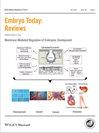Sharon B. Meropol, Amy Edwards
下载PDF
{"title":"Development of the infant intestinal microbiome: A bird's eye view of a complex process","authors":"Sharon B. Meropol, Amy Edwards","doi":"10.1002/bdrc.21114","DOIUrl":null,"url":null,"abstract":"<p>Infants undergo profound shifts in colonizing intestinal microorganisms during their first year, especially during and after birth and during weaning. Microbiota are passed to infants through the placenta, during the vaginal birth process, and from early diet and other environmental exposures. These microbiota play an active role in the development of healthy infant metabolic and immunologic systems; profound shifts in microbiotal populations can be persistent, are associated with immediate alterations in gene expression, metabolic, immunologic, and neurologic function, and with downstream metabolic and immunologic consequences such as obesity, allergies, asthma, autoimmune diseases, and potentially neurologic conditions. Many modern exposures, including Cesarean section, formula feeding, and antibiotics, have been associated with microbiome shifts, and also with downstream diseases; while many published studies considered exposures individually, a more comprehensive understanding of their interaction and impact will consider the entirety of the infant's environment. It is not possible, nor desirable, to return to a world without toilets, sewers, tap water, delivery room antisepsis, Cesarean sections, antibiotics, immunizations, and refrigerators; our other alternative is to better understand these complex changes in infant developmental and molecular physiology. Protecting and repairing the developmental processes of the healthy infant microbiome is the modern medical frontier. Birth Defects Research (Part C) 105:228–239, 2015. © 2015 Wiley Periodicals, Inc.</p>","PeriodicalId":55352,"journal":{"name":"Birth Defects Research Part C-Embryo Today-Reviews","volume":"105 4","pages":"228-239"},"PeriodicalIF":0.0000,"publicationDate":"2015-12-11","publicationTypes":"Journal Article","fieldsOfStudy":null,"isOpenAccess":false,"openAccessPdf":"https://sci-hub-pdf.com/10.1002/bdrc.21114","citationCount":"37","resultStr":null,"platform":"Semanticscholar","paperid":null,"PeriodicalName":"Birth Defects Research Part C-Embryo Today-Reviews","FirstCategoryId":"1085","ListUrlMain":"https://onlinelibrary.wiley.com/doi/10.1002/bdrc.21114","RegionNum":0,"RegionCategory":null,"ArticlePicture":[],"TitleCN":null,"AbstractTextCN":null,"PMCID":null,"EPubDate":"","PubModel":"","JCR":"Q","JCRName":"Medicine","Score":null,"Total":0}
引用次数: 37
引用
批量引用
Abstract
Infants undergo profound shifts in colonizing intestinal microorganisms during their first year, especially during and after birth and during weaning. Microbiota are passed to infants through the placenta, during the vaginal birth process, and from early diet and other environmental exposures. These microbiota play an active role in the development of healthy infant metabolic and immunologic systems; profound shifts in microbiotal populations can be persistent, are associated with immediate alterations in gene expression, metabolic, immunologic, and neurologic function, and with downstream metabolic and immunologic consequences such as obesity, allergies, asthma, autoimmune diseases, and potentially neurologic conditions. Many modern exposures, including Cesarean section, formula feeding, and antibiotics, have been associated with microbiome shifts, and also with downstream diseases; while many published studies considered exposures individually, a more comprehensive understanding of their interaction and impact will consider the entirety of the infant's environment. It is not possible, nor desirable, to return to a world without toilets, sewers, tap water, delivery room antisepsis, Cesarean sections, antibiotics, immunizations, and refrigerators; our other alternative is to better understand these complex changes in infant developmental and molecular physiology. Protecting and repairing the developmental processes of the healthy infant microbiome is the modern medical frontier. Birth Defects Research (Part C) 105:228–239, 2015. © 2015 Wiley Periodicals, Inc.

 求助内容:
求助内容: 应助结果提醒方式:
应助结果提醒方式:


